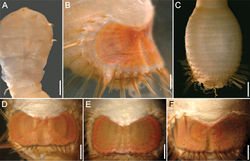Sternaspis andamanensis
| Notice: | This page is derived from the original publication listed below, whose author(s) should always be credited. Further contributors may edit and improve the content of this page and, consequently, need to be credited as well (see page history). Any assessment of factual correctness requires a careful review of the original article as well as of subsequent contributions.
If you are uncertain whether your planned contribution is correct or not, we suggest that you use the associated discussion page instead of editing the page directly. This page should be cited as follows (rationale):
Citation formats to copy and paste
BibTeX: @article{Sendall2013ZooKeys286, RIS/ Endnote: TY - JOUR Wikipedia/ Citizendium: <ref name="Sendall2013ZooKeys286">{{Citation See also the citation download page at the journal. |
Ordo: Canalipalpata
Familia: Sternaspidae
Genus: Sternaspis
Name
Sternaspis andamanensis Sendall & Salazar-Vallejo, 2013 sp. n. – Wikispecies link – ZooBank link – Pensoft Profile
Type material
Andaman Sea, Thailand. Holotype (ZMUC POL-2157) and two paratypes (ZMUC POL-2158), 7°00'00"S, 99°15'00"E, 45 m, 6-V-1996.
Additional material
Andaman Sea, Thailand. 1 spec. (PMBC K1-0S), 7°00'00"S, 99°16'00"E, 41 m, 24-II-1998. South China Sea, Malaysia. 1 spec. (AM W 196244), Sarawak, 1982. One spec. (AM W l96245), Sarawak, Bintulu, 5.5 m, 1982.
Description
Holotype (ZMUC POL-2157) with pre-shield and shield regions rounded, much wider than anterior region which is elongate, narrow and bent inwards (Fig. 6A, B). Body papillae few, evenly and widely spaced as filaments over most of surface on segments 1–7; fewer, shorter papillae on segments of shield region. Body up to 8.5 mm long, 5 mm wide, about 28 segments.
Prostomium almost spherical, pale yellow. Peristomium oval, raised at position of mouth. Mouth small, covered by papillae, positioned between prostomium and anterior border of second segment.
First three chaetigers with 10 larger and up to five smaller flat, bronze, closely associated, falcate hooks per bundle, almost traversing each segment (Fig. 7B, C); hooks with shaft milky, median or subdistal area dark, distal portion light gold. One pair of genital papillae protrude ventrally from intersegmental furrow between segments seven and eight. Pre-shield region with 7 segments, with 2–3 fine capillary chaetae protruding laterally from body wall on some segments.
Ventro-caudal shield ribs barely noticeable, concentric lines not visible; suture poorly defined, apparently extended throughout shield (Fig. 7D). Anterior margins angular; anterior depression deep; anterior keels exposed, with median notch. Lateral margins curved, expanded medially, reduced posteriorly. Fan truncate with two lateral notches and a median, rounded projection, not extended beyond posterior corners, margin denticulated.
Marginal chaetal fascicles include nine lateral ones, chaetae ovally arranged, and five posterior fascicles, chaetae in evenly spaced straight rows. Peg chaetae translucent, lighter in colour than other marginal chaetae, as long as, or longer than posterior fascicles chaetae. Peg chaetae emerge from under shield on a fleshy cone, with a wide base in cross section. Additional fine, short, capillary chaetae next to peg chaetae, medially to first fascicle of posterior shield chaetae.
Branchiae few, stout, tightly coiled (Fig. 7E), protrude from two almost parallel plates.
Etymology
The species name is derived from the Andaman Sea and the suffix indicates it lives in that region.
Type locality
Andaman Sea, Thailand, 45 m.
Remarks
Sternaspis andamanensis sp. n. differs in several features from any other species. The arrangement and sparseness of papillae on the cuticle, a narrow anterior region, milky introvert hooks, long and translucent peg chaetae, hourglass-shaped shield, shield chaetae protruding from a translucent band of cuticle around the shield, and posterior chaetae along the shield in an almost continuous row, are all significant differences. The other species having a shield with a denticulate posterior margin is Sternaspis africana but besides the differences in body papillation which is evident in Sternaspis africana and missing in Sternaspis andamanensis, the general shape of the shield differs as well. In Sternaspis andamanensis the anterior margins are projected markedly beyond the anterior depression, and the fan is medially markedly projected and the lateral notches are deep, whereas in Sternaspis africana the anterior margins are not so projected beyond the anterior depression, and the fan is barely projected medially and there are no lateral notches.
Distribution
Known from two locations: Thailand in the Andaman Sea and Malaysia in the South China Sea, 5–45 m depth.
Original Description
- Sendall, K; Salazar-Vallejo, S; 2013: Revision of Sternaspis Otto, 1821 (Polychaeta, Sternaspidae) ZooKeys, 286: 1-74. doi
Images
|

